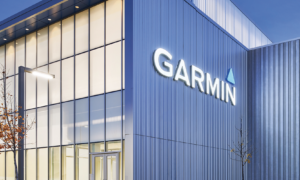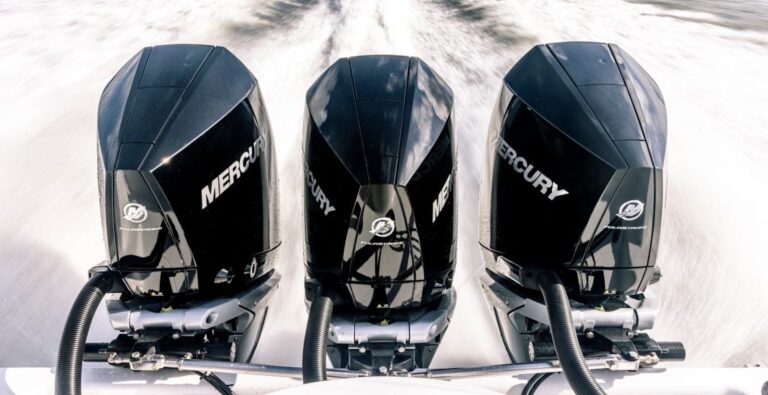
Founded in 1956, Lippert is a powerhouse in the RV and marine OEM and aftermarket segments. It owns such well-known marine brands as Lewmar, Taylor Made, SureShade, Trend Marine and Marine Trailer Performance, and RV brands including Furrion, Polyplastic, Solera, Somnum and others. In addition, Lippert manufactures a broad array of products, everything from RV slide-outs, RV and mobile home chassis, mattresses and glass solutions for all types of vehicles to boat anchors, trailer hitches, electronics and more.
The company is headquartered in Elkhart, Ind., runs 140 manufacturing and distribution facilities and employs 12,500 employees around the world. It posted net sales of $5.2 billion and net income of $395 million during fiscal year 2022.
North American group president Ryan Smith has been with Lippert for 18 years, and has a passion for the RV and marine spaces. We caught up with him in early February to discuss the similarities and differences between the RV and marine markets, as well as the unique challenges and opportunities in each segment. (This interview has been lightly edited for clarity and length.)
What can you tell us about your personal and professional backgrounds?
I was born and raised in the heart of the RV industry, and this place has the most special piece of my heart. I cut my teeth in RV sales at a young age and continue to fall in love with this business of outdoor recreation as I work with my friends and neighbors to bring Lippert innovation and safety to this industry.

The recreational boating space is a personal hobby of mine and has been such a natural space for Lippert to grow into, as our capabilities, knowledge and vision align in that direction.
Are there any boating or outdoors hobbies you enjoy?
I have a boat that my family and I enjoy taking out and creating memories together on the lake by our home. It’s our favorite summer pastime, and it’s becoming more important as my kids are growing up. I love spending time with my kids, outside shooting hoops or getting involved in our community.
What has driven Lippert’s successes for nearly 70 years?
Lippert has a robust history of innovation and constantly pushing the envelope in this area. We have the unique opportunity to speak directly with campers, boaters and outdoor enthusiasts wherever they play, and we take their feedback very seriously. We’ve built our company around the ethos that we should solve the problems of our customers and make their solutions our business. We aim to make their experience better.
How many plants, warehouses and other facilities does the company utilize?
We have over 100 plant locations and warehouses in five countries. We are constantly aligning our facilities and capabilities to our customers’ needs wherever they are to make their life easier.

The RV and recreational marine markets have returned to prepandemic conditions. How is this affecting business?
It’s great because we feel focused and ready to innovate on all of the actionable customer feedback we’ve had the last few years. We had a ton of new folks enter the recreation markets, and we heard a lot of different ways we can make their experience outdoors with their friends and family a lot easier and more smooth. Now, after the last few years that we have had, we spent the time building up the capabilities and quality processes to take the lead in this market and crush competition. We’ve gained a lead, and we have just started buckling down, so the competition doesn’t stand a chance to catch up now.
Supply-chain issues were perhaps the most painful aspect of the pandemic. Are you still facing challenges getting materials?
We got nimble and really creative like we always do in tough times. This is how we have always gotten through multiple recessions and downturns in the industry. We used that challenge to sharpen our people, develop our leadership and refine a lot of our processes. Tough times showed us a few of the cracks that we could shore up, so we’ve spent more time focusing on that. We’ve gotten aggressive with our supplier strategy, and we’re constantly refining the way we approach this critical piece of the puzzle to keep lead times down for our customers.
What types of trends are you seeing in the RV segment that mirror the recreational marine segment?
Customers want convenience. When you’re enjoying your time on the boat or at the campground, you don’t want to lift a finger. Just like at home, we are taking automation, AI and touch-control technology into consideration when we design and develop new marine innovations. Nothing about your boating day should be work or something you dread. From dock to dock, we’ll provide a pleasant, easy experience that makes you look forward to bringing your boat out every season.
Finding skilled labor is a challenge for the boating industry. Is the RV industry facing the same problem?
We are heavily investing in trade schools and the upcoming generations of technical leaders. We offer competitive packages like a lot of other companies in this industry, but we play the long game. We are looking to raise the next generation of welders, fabrication techs, engineers, seamstresses and more. We invest in our people and want to raise future leaders and technically skilled team members in the Lippert culture.
Your company specializes in offering many different products. Which segment is the largest by volume?
Our bread and butter will always be in our roots: the RV industry. We supply about 90% of chassis on RVs on the road today. We’ve segued that into a healthy axle business, steps, doors and more.
Where are you seeing the most innovation in the RV space?
Anything that helps campers have a safer, more convenient and comfortable experience to have fun with their friends and family. Customers wants safety, first and foremost. The towing experience needs to be simple and seamless, like with our Lippert anti-lock braking systems applying the safety of automobiles to towable trailers behind the vehicle. Then there is the hitch mechanism that needs to be secure, safe, reliable and simple. New folks trying to enjoy boating or camping don’t want to worry about a 15-step process to connect their towable unit and their vehicle. We’ve seen this friction point and are determined to eliminate the impediments to having fun outside, making it safe, simple, fun and convenient all the time.
You can have the most state-of-the-art or flashy RV with the newest finishes, but at the end of the day, the unseen parts of the RV need real innovation since the first RVs of decades ago. We continue to look at all parts of the boat or RV and come up with ways to think about solutions differently than the competition.
Of all your marine segments and products, which is the biggest by sales volume?
Seating and glass solutions continue to be where we win. We have robust capabilities, and cutting-edge talent and tooling, centered around these two categories. This is where our expertise in the RV industry, cross-functionally, benefits all of our customers. We’ve been building quality modular storage seating for other industries for years, and take that innovation and expertise to the marine industry in a fresh way.
What is Lippert’s distribution strategy?
Lippert partners with most of, if not all, the largest national and regional distributors in every market it serves, including the RV, marine and automotive aftermarkets. There really isn’t a major distributor that we don’t do business with. The distribution model works well for us, and works well for the dealer and end consumer because they can get the product they need, when they need it.
The recreational marine industry has come a long way in the last decade to be more inclusive and diverse. How about at Lippert?
In 2022, our board of directors was thrilled to increase the overall diversity of the board to 45%, with 27% female representation and 18% of members representing racially diverse backgrounds. We believe these different perspectives will make us stronger as a team and help us identify innovative ways of doing business.
We know that a healthy, strategic organization is going to be stronger and be able to better represent a global consumer base.
We work hard to develop our current and future leaders with this mindset. We hire differently than our competitors, looking for soft skills and a leadership mentality where they are usually just trying to fill a seat on the line. One change during Covid-19, like many companies, we hired many functions remotely. This contributes to our diversification strategy and opens up a world of talent beyond our home region of Indiana.
Your team of 12,500 has volunteered 100,000-plus hours to support various causes. Can you tell us about that?
To us, it is mission critical to contribute to thriving, healthy communities where our team members live, work, play and raise their families. We know this will contribute to happier, healthier teams and folks that find different facets of fulfillment at work. Our Lippert Cares organization is a team of internal folks dedicated to involving our team members in this cause. It’s not mandatory, but it’s woven through our DNA and is a great way for our teams to come together for a common cause and bond. Community service, for us, isn’t just a marketing or P.R. opportunity. It’s part of who we are and how we connect with each other and our community.
What is the most rewarding part of your job?
Taking a customer challenge and solving it for them. Taking something that seems impossible or insurmountable to them and watching how our team attacks the problem with creativity and positivity. It’s inspiring to watch. These customers are so grateful. They know we couldn’t do this without one another, and it turns into a tremendous relationship where we are constantly building each other up and making better end products for consumers as a result.
What is the most challenging part of your job?
It will always be the unpredictable nature of the world. In the last four years, we’ve seen some tough world events that have impacted our business and our people in a very real way. We do what we can to mitigate impact and future-proof our company, but life still hits us hard sometimes, and it’s never easy to see team members and friends struggle.
Plenty of companies are working to reduce their carbon footprint. What is Lippert doing to curb its carbon output?
Since our inception in 1956, we have strived to be a strong manufacturing partner to our customers and a good corporate partner to our team members, our community, our customers and the environment. Our sustainability approach was first ignited by our passion to protect and invest in the communities we call home, and has evolved over time to be more holistic. We have incorporated sustainability practices and processes into all facets of our business operations.
At the production level, Lippert aims to protect the environment and save resources by selecting sustainable materials and reducing the environmental trace of our production processes. We emphasize the use of environmentally friendly materials and processes whenever practicable, especially for packaging, and we work to improve our recycling and sustainability programs every year.
In our day-to-day business operations, we have become conscious of our use of natural resources and generation of waste, and have started tracking this data to establish a solid baseline that will permit us to set realistic reduction goals while looking for added process efficiencies. We have always invested in our team members and strongly believe in upholding our value: “everybody matters.” We have made strides to improve retention, encourage physical and mental health, and provide resources to support our team members and their families. We work hard to improve our operational health and safety protocols, and are proud to see those bear fruit. We are still early in our DEI journey, but we are proud of the magnitude of our achievements in a short time period.
In 2022, we continued to support our communities through the Lippert Cares program, where team members donated their time and effort. We also launched a brand-new grant program, where nonprofits were able to apply for and be awarded up to $50,000 for mental health and leadership programs for at-risk youth. With the success of the grant program, we hope to expand its reach in the following years.
Finally, we hired our first sustainability leader to join our team in 2022, to help us further identify environmental, social and governance opportunities, and ensure that existing processes are functioning appropriately. Our corporate director of sustainability is highly qualified in engineering and sustainable business operations, with over a decade of experience in orchestrating sustainability strategy, development and implementation. We established a new ESG Steering Committee, which reports to the Corporate Governance, Nominating and Sustainability Committee of the board of directors and brings together cross-functional executive leaders, each of whom plays an important role in furthering our ESG strategy. We certainly are proud of our progress and are looking forward to continuing our ESG journey
Are there any other environmental initiatives you’d like to tell us about?
Specifically for our marine divisions, in 2023, we partnered with Oasis Marinas to clean up marinas and waterways around the country. We have an international initiative called Lippert seRV where full-time traveling families can be a part of community service in whatever community they are visiting. It’s an innovative way to take service on the road and get involved in various areas where you may be transient, leaving somewhere better than when you found it.
Mergers and acquisitions seem to be accelerating again. What does Lippert look for when acquiring a company?
We are constantly looking for strategic ways to invest and divest assets that make the most sense to our customers. Location, capabilities and new technology all play an important role in the decision-making process. At the end of the day, we ask ourselves, “Will it serve our customers better?” And most of the time, there is an obvious answer.
This article was originally published in the March 2024 issue.











